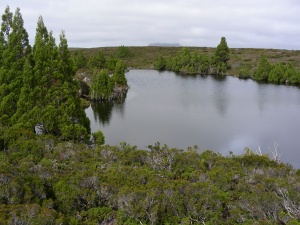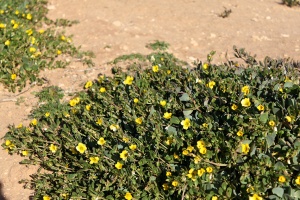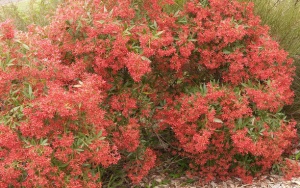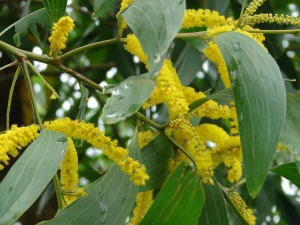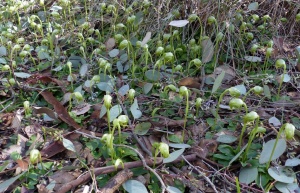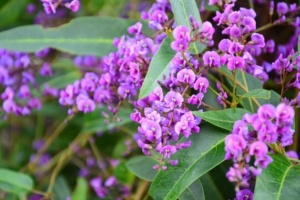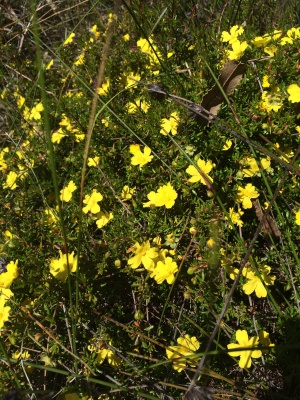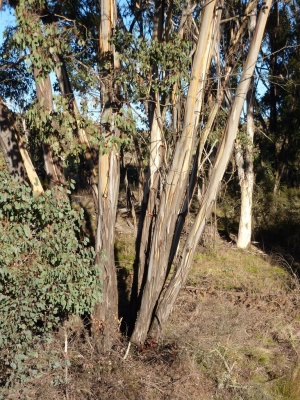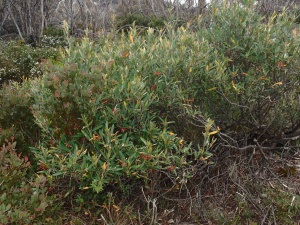Jen Sutfin
Pencil Pine
Pencil pine is slow-growing; it can take more than 50 years to reach 1 m tall, but it can live for 1300 years, placing this species amongst the longest lived trees in the world.
A conifer tree usually with a classic conical shape. Grows up to 15 m tall, smaller in exposed environments. Older trees often have multiple trunks and some dead branches.
Leaves
Individual leaves mid to dark green, small (3-5 mm long) and scale-like, closely clasped to stems. Leaves densely arranged around stems, forming a rope-like branchlet less than 5 mm in diameter.
Cones
Male and female cones usually on separate branches, at the tips of the stems. Male cones small (4 - 5 mm diameter), develop between February and May, persist until spring. Female cones 12 - 15 mm diameter, develop between September and February, cones can persist for several months after seed shed in autumn. Gold in colour, becoming reddish-brown with age.
Large quantities of cones are produced during ‘mast’ years, typically every 5 - 6 years, with much less fruiting in other years.
Pale Twin-leaf
Annual herb or perennial sub-shrub up to 20 cm tall, often forms a mat up to 2 m in diameter. Pale four-petalled yellow flowers.
Leaves
Distinctive leaves made up of two fleshy Y-shaped leaflets looking like butterfly wings. Leaves are ovate with a narrow end at their base. Leaves grow between 1 - 4 cm long and are fleshy, a dull grey-green or green.
Flowers
Bright yellow in colour with four petals growing between 8 - 15 mm.
NSW Christmas Bush
Its genus name Ceratopetalum means horned-petal after one of the species that has petals resembling stag’s horns, and its species name gummiferum means gum-bearing after the gum that oozes out of its bark.
Evergreen shrub or small tree, up to 10 m high and 6 m wide, but much smaller when grown in gardens where it reaches a height of only 2 – 5 m.
Leaves
Glossy green and made up of three leaflets which are 3 – 8 cm long and 0.5 – 3 cm wide when mature. They are thin, with serrated edges, and are a golden orange-red colour when young.
Flowers
Initially creamy white and star-shaped, forming clusters that are 10 cm long. Each flower has five petals that are about 3 mm long. After pollination the white petals fall off, leaving the outer sepals which enlarge to about 12 mm long and turn deep pink to orange-red. These “flowers” consist of five sepals and are also star-shaped. They are commonly mistaken for flowers, but the real flowers are the less noticeable white ones.
Northern Black Wattle
Fast growing medium-sized tree, 16 - 30 m tall that forms dense foliage cover. It is particularly drought resistant, and tolerates poor soil conditions.
Leaves
Long, slightly curved leaves 10 - 20 cm long.
Flowers
Grouped yellow flowers in a spike, up to 8 cm long, develop from February to August.
Nodding Greenhood
Flowering orchid up to 30 cm tall.
This orchid is pollinated by a species of fungus gnat, attracted to the flower by a chemical produced by the plant. The insect enters the flower, which temporarily traps it inside, and in attempting to escape, it comes into contact with the sexual organs of the flower and pollination occurs.
Leaves
Egg-shaped to elliptic dark-green leaves in rosette arrangement at the base of the stem, 3 – 9 cm long, 1 – 3 cm wide. Leaf margins wavy or crisped.
Flowers
Single flower ‘hood’ emerging on a flowering spike 8 - 30 cm tall. Flowers are 1.8 – 2.5 cm long, showing a strong ‘nodding’ position; and are a translucent white colour, with green stripes and orange/brown colouration at the tips.
Native Wisteria
The genus name Hardenbergia is named after Franziska Countess von Hardenberg and the species name comptoniana after Mary, 1st Marchioness of Northampton whose husband was Charles Compton.
Twining shrub or climber. Its size varies depending on supporting plants or structures it is growing on.
Leaves
Usually crowded, 3 and sometimes rarely 5 foliate. Leaflets are 4 – 6 cm long., and do not spread very widely. Size approximately 2–4 mm long and 1 mm wide, thick, concavo-convex (concave on both sides) and pointed at ends.
Flowers
Blue to purple and in some cases white. Typical pea shape consisting of 5 petals: the "standard", the "keel" (2 fused petals) and two "wings". Flowers are in an often drooping, elongate cluster.
Native Morning-glory
Its genus name Ipomoea is from the Greek 'ips' or 'ipos', a worm that eats horn and wood, and probably refers to the long slender stems. Also known as Poison Morning Glory referring to its toxicity and the morning opening of the showy flowers, followed by their closing in the afternoon.
Sprawling perennial ground cover, up to 3 m wide, with twining stems.
Leaves
Heart shaped dark green leaves are up to 4 cm long and 2 - 3 cm wide.
Flowers
Lilac or pink flowers have a darker throat and are shaped like a funnel or trumpet. Flowers are up to 4 cm long and 5 cm in diameter.
Field Guide
Improve your identification skills. Download your Native Morning-glory field guide here!
Native Buttercup
Erect spreading dark green shrub. 0.2 – 1 m high.
Leaves
Long, narrow, oblong, blunt, dark green above with very recurved margins.
Flowers
Stalked, yellow flowers with 5 distinct petals. The stamens are all found on one side of the centre of the flower and look like a tiny hand of bananas.
Mountain Swamp Gum
Straggly to erect tree up to 20 m tall with a rounded canopy.
Smooth and grey bark on top trunk; dark grey, scaly and shedding in ribbons on lower trunk.
Leaves
Juvenile leaves are thick, egg-shaped to round. Often notched on end. 7 cm long and 5 cm wide.
Adult leaves are dull green, broad, elliptic (shaped like a flattened circle) to egg-shaped 8 - 15 cm long and 2.5 - 6 cm wide with dense veins and petioles (leaf stalks) up to 3 cm.
Flowers
White inflorescence (flower clusters).
Flower buds up to 7 narrow diamond-shaped buds < 0.7cm long. Commonly 7 per cluster. Similar to E. ovata but narrower.
Mountain Grevillea
Erect, spreading shrub growing to approximately 1.5 - 3 m high and 1.5 - 4.5 m wide. Branchlets are densely covered in small, white hairs.
Leaves
Leaves are elliptic (rounded) to lanceolate (lance-shaped), and about 6 - 12 cm long and 10 - 45 mm wide. The upper surface of the leaf is olive green in colour, smooth and semi-glossy with the underside being a pale-green/white colour, covered in white hairs. Leaf margins are flat or slightly recurved.
Flowers
Produces red or reddish brown flowers that bloom at the end of branches. Flowers are trumpet-like measuring 3 - 17 mm long and 1.2 - 1.6 mm wide, a single stem shoots from the flower and measures 17 - 90 mm long.

